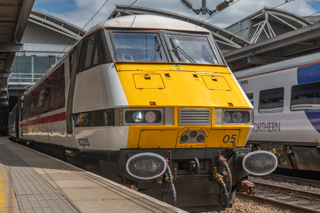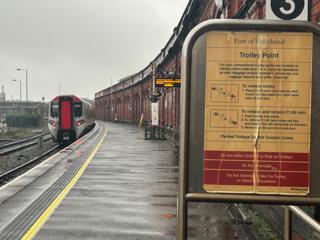Thankfully, railway closures are rare today - especially passenger lines, unless they are replaced by a better alternative. But that has not always been the case - the railway is still feeling the massive effects of the Beeching modernisation plan of the early 1960s (see panel, page 75).
To be fair, in the 1960s, restructuring the loss-making railways was understandably necessary. Some lines were no longer needed, and the railway was woefully overstaffed. Additionally, the way we travelled and moved freight was changing, with a surge in car ownership and a better, leaner road haulage industry.
Sadly, the biggest single oversight of implementing Beeching’s plan, or indeed any railway closure, was not protecting trackbeds once the rails had been lifted. If lines had been mothballed, or if ownership of the trackbeds had been retained by British Rail even after they were ripped up, with developers barred from building on them, things could have been so much different. Reopening lines would also have been a lot easier, especially if legislation existed to allow railways to be reinstated without costly consultation.
But they weren’t. Today, with a rising population, the demand for rail travel has increased. Yet reinstating railways is so much more difficult and costly. And because of the latter, often they duly don’t make a strong enough economic case. Ironically, a lot of that cost is not the actual physical rebuilding of the infrastructure.
Unfortunately, there will always be opposition to any building of a new railway - even if it’s on an old trackbed - from those who live next to it or close by. That’s why there is so much opposition to HS2 - it’s people not wanting a railway near them. It’s classic ‘not in my back yard’ NIMBYism.
But of all those lines which have been long closed and ripped up, which ones could we really do with today? Here’s my own wish list, in no particular order…
Let’s be clear: in many cases it’s hard to argue (economically) that these lines should be relaid, because events have overtaken us and it’s no longer that easy to re-lay a railway. That said, I will at least try to present some arguments for re-opening, although in most cases I doubt that they ever will. I am merely suggesting lines that would have been very useful today, and how UK plc could have benefited.
Meldon to Bere Alston
At first, these two towns in Devon might not seem to be hotbeds of railway activity, but it’s the bit in between that we could really do with today.
The fact that Meldon and Bere Alston themselves remain on the network highlights the sheer folly of some of the line closures. What was gained by closing the 20 miles of railway that once linked them?
It was deemed that the route via Meldon was a duplicate line between Exeter and Plymouth. But for duplicate, I read alternative. And when you consider that closing it meant only one route was retained between the two cities (via the Dawlish Sea Wall), alternative becomes a far more powerful word than duplicate.
It would provide a diversionary option if the existing line via Dawlish is closed, as it so often can be. Who can forget the 2014 closure of this line that cut off Devon and Cornwall for two months from February to early April?
Relaying this line would prevent that. It would also be a scenic tourist line - you could run an Exeter-Plymouth-Bere Alston-Okehampton-Exeter circular steam-hauled service and never have to turn the locomotive!
March to Grimsby
This line actually closed in several stages, and part of it does actually remain open, but again it highlights a short-sighted closure.
The line from Grimsby to Firsby South Junction closed on October 5 1970 (apart from the 13 miles to Louth, retained for freight until 1981), along with the section from Boston to Spalding. South of Spalding, the line to Peterborough was also closed to passenger traffic at the same time, although this was quickly reversed and reopened in 1971.
The line from Spalding to March closed ‘as recently’ as November 27 1982. And when it did, it meant all freight from East Anglia to Yorkshire had to run via Peterborough. This is now a major bottleneck, and there have been calls in recent years to relay the line from March to Spalding. Sadly, that is unlikely to ever happen as so much of the trackbed has been built on and bridges removed.
While March to Spalding is the biggest ‘miss’ from today’s railway, the line through to Grimsby would have been an alternative route to and from the port of Immingham, opening up avenues for traffic from London and the Home Counties to avoid using the busy East Coast Main Line.
Tweedbank-Carlisle
This is a line that could, possibly, one day reopen.
The Waverley route was a controversial post-Beeching closure on January 6 1969. The recent reopening of 30.5 miles of the route, to Tweedbank, has been a major success. Indeed, so popular has the rail service been, that it’s now being argued that too much of the line is just single track.
There was talk at the end of the 1990s about relaying the line from Carlisle north into the Kielder Forest for timber traffic. That didn’t happen, but momentum is now building to reopen the 65 miles from Carlisle to Tweedbank.
Why? Well, it would offer an alternative route to Edinburgh. But it would also be a popular line, and give a much-needed boost both for commuting into Carlisle and to the populations in a beautiful part of the UK that is all too often sadly overlooked.
Lewes to Uckfield
The line to Uckfield was truncated on May 4 1969, and the eight miles south to Lewes were cut.
In hindsight, this again seems to be short-sighted. Uckfield is a busy commuter town for those who want to work in London but live well away from it - it’s a 78-minute journey into London Bridge.
Relaying this line would allow an alternative route from London to Brighton, serving different populations.
Part of the line, from Isfield to Worth Halt, is in use as the heritage Lavender Line, so any reopening would rely on a deal being struck to return this to the national network.
Stanley Junction to Kinnaber Junction
Closing some lines was based on poor patronage, but after cessation of the passenger trains some lines were retained for freight only. A classic closure of 1967 was that from Stanley Junction (just north of Perth) to Kinnaber Junction (near Montrose). This was part of a through route from Aberdeen to Perth and ultimately Glasgow.
When the 46-mile line closed, remarkably over two-thirds of it was initially retained! The 26 miles from Stanley Junction to Forfar and the five miles from Kinnaber Junction to Bridge of Dun (and on to Brechin) were both still in use into the 1980s, some 15 years after closure!
Forfar eventually lost its sparse freight traffic in 1982, Brechin having done so a year earlier. So until 1981 the only bit of the line actually closed and lifted was the 15 miles from Forfar to Bridge of Dun.
So, why would it have been a useful line today? Well, Angus is busy with freight, much of it agricultural, yet all of it goes by road. And the road network is nothing to shout about - trucks are forced to pick their way through some fairly sizeable towns such as Blairgowrie and Coupar Angus.
Could it reopen? Much of the trackbed exists, but it has been built on at a number of places, especially at Stanley Junction where the line left the Highland Main Line. So its chances of being rebuilt are, sadly, probably ‘nil’.
York to Beverley
Here’s a bizarre situation. Recently, a campaign group was trying to protect the trackbed at Market Weighton from being sold for development, with a view to ensuring that the line stood a chance of being reopened. It lost its case, so houses can now be built there instead.
Thus we have a situation where the population of Market Weighton, a town popular with people commuting to York, Hull and Leeds, will increase. Yet the ability to (easily) reinstate a railway to serve them is being lost. That smacks of shortsightedness of the highest order!
Market Weighton was actually a junction town, and the intersection for the lines from York to Beverley (and on to Hull) and from Selby to Driffield (and on to Scarborough).
If both of these lines had survived, there would have been great benefits to the populations in East and North Yorkshire. It would have opened up more opportunities, and addressed congestion in York and Hull.
Northallerton to Church Fenton
Staying in Yorkshire - if the East Coast Main Line is closed north of York, the railway is stuffed! Short of going via Leeds and Carlisle, there’s no obvious way north.
And imagine if the ECML was incapacitated for any length of time? For London to Scotland journeys there is the option of the West Coast Main Line, but could that cope? Probably not.
Had this line survived, then not only would it serve the sizeable community of Wetherby (20,000), it would also have carried on north via Melmerby and joined the ECML at Northallerton - allowing trains to head either direct via Darlington or head to Middlesbrough and Sunderland.
The lines through Wetherby closed on January 6 1964 and through Melmerby on March 6 1967. Much of the trackbed is untouched, but (like so many closed lines) the areas close to conurbations are often built on.
Like the Bere Alston to Meldon line, this route would have made an excellent diversionary and alternative line, rather than a duplicate route.
Padstow to Boscarne
Have you ever been to the delightful harbour town of Padstow, in north Cornwall, in the summer? It’s gridlocked. The nearest car park to the town is ironically on the land of the old station. If only there was still a railway there!
Padstow was served by the London and South Western Railway, with a line from Exeter via Crediton, Okehampton, Halwill Junction & Beaworthy, Launceston, Camelford and Wadebridge. At Wadebridge the line from Bodmin also came in.
Closure came in 1967, while the line from Bodmin Road to Bodmin General, Boscarne and Wenfordbridge was retained for freight until 1983 - after the section for Boscarne Junction to Wadebridge had closed in early 1979, again having been retained for freight.
The trackbed of the majority of the ten miles from Padstow to Boscarne Junction is still intact and used as a cycle way, although the section where the railway once went through Wadebridge has been lost to development.
The Bodmin & Wenford Railway, which currently runs from Bodmin Parkway to Boscarne via Bodmin General, has aspirations to relay the line to ‘just outside’ Wadebridge. However, the current plan would fall half a mile short of the surviving station, now in private use.
Realistically, getting the railway any further than the outskirts of Wadebridge is ‘unlikely’. And just a footnote here: isn’t it time the railway to Fowey was revived for passenger use?
Carmarthen to Aberystwyth
Wales was ravaged by closures in the 1950s and 1960s. The result was a number of ‘very long’ branches from the borders: from Chester to Holyhead; from Shrewsbury to Aberystwyth and Pwllheli; and from Swansea to Fishguard, Milford Haven and Pembroke Dock.
With the exception of the Llanelli-Craven Arms ‘Heart of Wales’ line, there was nothing to link any of these routes - and the ‘Heart of Wales’ barely did that. To the west of the country there was nothing.
The line from Carmarthen ran via Pencader (the junction for the Newcastle Emlyn branch), Lampeter (with a branch to Aberaeron), and north through Strata Florida to Aberystwyth (where it met with the line from Shrewsbury).
The route closed on February 22 1965 (flooding was the reason for suspending the services, which never restarted), although the lines to Newcastle Emlyn, Lampeter and to Felin Fach and Port Llanio were retained for freight (mostly milk). This naturally dwindled as road haulage became cheaper, and the line was closed in 1973.
There is a campaign to reopen the line to Lampeter, but because the populations in the area are slim it would seem unlikely. That said, the sparse habitation does mean much of the trackbed is still intact.
This is a classic line where while there is no case for reopening, if the line had survived it might today be viable - especially given that it travels through some superb scenery.
A few miles of the line north of Carmarthen have been relaid as the Gwili Railway.
Dyce-Fraserburgh/Peterhead
Another line which closed to passengers but lingered for freight.
Peterhead closed to passengers on May 3 1965, and Fraserburgh followed shortly afterwards on October 4. Peterhead then stayed open for freight until 1970, when the line from Maud Junction was closed. Fraserburgh fared slightly better, with traffic surviving until 1979.
Both terminus towns have relatively sizeable populations (about 19,000 and 13,000 respectively). Meanwhile, Ellon (north of Dyce and on the route) is another growing town of over 10,000.
The biggest issue is that nearby Aberdeen is growing. And like any growing conurbation, there is always a demand for transport options for those people who have moved out of the city and who are looking to live further afield and commute into their jobs. And as we all know, commuting is often better done by rail.
While much of the trackbed to Fraserburgh is still intact and free of development, as is that to Peterhead until you get to the town itself, this is arguably a borderline case for reopening.
This is certainly the case for all of the 38 miles from Dyce to Peterhead and the 15 miles from Maud to Fraserburgh. However, the 40-mile Dyce to Fraserburgh line certainly has a degree of merit.
This feature was published in RAIL 823 on 25th March 2017
















Rob - 29/01/2018 10:32
I'm opposed to hs2 because of its escalating cost,length of time and the fact when its finished it will be like concorde the majority wont be able to afford to use it.except for Mr barrister who wants to fall out of bed in Birmingham at 7am x stroll thro the front doors of the old bailey at 9..this isn't nimbyism spend the money repairing beatings fuel up .